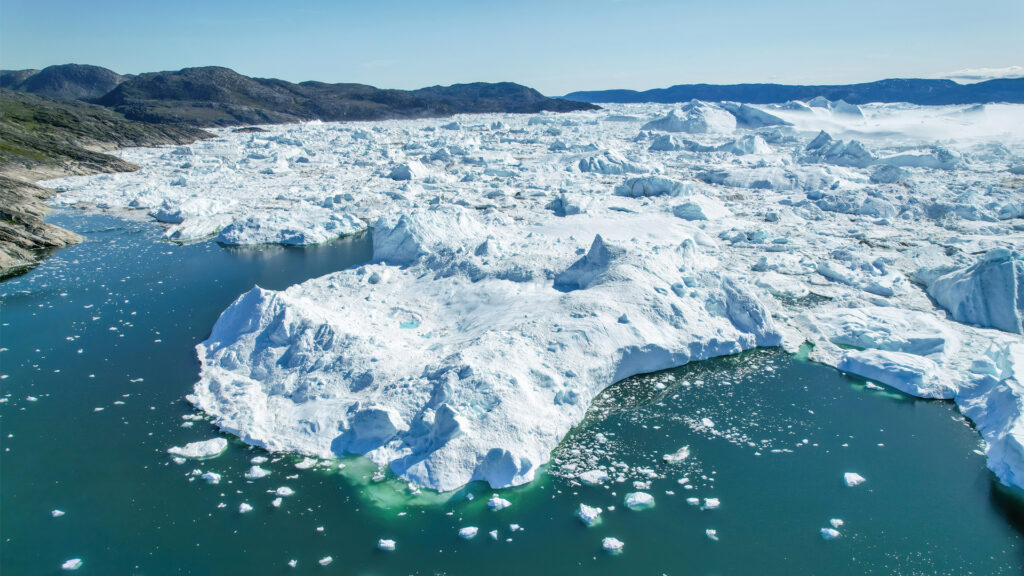By Kim Ross and Daniel Reifsnyder
The fate of Florida and Greenland are intertwined as they share something in common: rising seas.
In fact, ice melt in Greenland is already a major factor in the sea level rise now impacting the Florida coastline. According to the National Geological Survey for Denmark and Greenland, Greenland’s ice sheet continued to be the largest source of sea level rise in the world in 2024.
The important and central question about Greenland is whether the world will continue to raise global temperatures and watch the Greenland ice sheet melt away. The ice sheet holds enough ice to increase sea levels by 23 feet – wiping out much of the coastal world.
President Donald Trump has repeatedly asserted his desire to acquire Greenland for reasons of national security and access to critical mineral resources. He has not ruled out military action to do so. However, rather than flexing imperialistic ambitions, the United States should engage in multilateral negotiations and address the shared challenges posed by a warming planet.

Recently, Secretary of State Marco Rubio acknowledged the region’s melting ice in terms of shipping lanes. Yet he ignores the flooding, property loss and economic impact that rising seas caused by Greenland’s melting glaciers have on his own hometown of Miami.
Now, U.S. Sen. Ted Cruz (R-Texas), chair of the Senate Committee on Commerce, Science and Transportation, will convene a hearing on Feb. 12, “Nuuk and Cranny: Looking at the Arctic and Greenland’s Geostrategic Importance to U.S. Interests,” to discuss and potentially support President Trump’s ill-advised ambitions to exploit Greenland to the detriment of coastal communities everywhere.
If the U.S. was operating in our best interest, rather than planning to take over Greenland, we would engage with Greenland and Denmark to halt the disintegration of the Greenland ice sheet. Together, we should propose an upper limit to sea level rise to serve as a rallying point for international cooperation.
The U.S. and other developed countries are largely responsible for the climate pollution causing Greenland’s glaciers to melt, and Florida is now routinely experiencing the impacts of accelerating sea level rise and related storm surge and flooding. The United Nations notes risks to island states, coastal zones of densely populated countries and major cities on every continent, including Bangkok, Buenos Aires, Lagos, London, Mumbai, New York and Shanghai.
That brings us to Florida’s low-lying coastal cities, like Miami, which already endure sunny-day flooding, impeding access and mobility in their streets. Sea level rise is also making saltwater intrusion worse and impacting groundwater supplies. Meanwhile, a growing number of insurance companies are refusing to cover Florida properties at risk of flooding or are charging ever-increasing rates. The economic impacts on tourism, infrastructure and ports reverberate far inland.
Sea levels across Florida are as much as 8 inches higher than they were in 1950, and the rate of sea level rise is accelerating. Some amount of sea level rise is “baked in” due to past and future increases in global temperatures. Current data indicate that 2024 will likely be the first calendar year exceeding a 1.5°C increase over pre-industrial norms. 2023 surpassed the previous warmest year – 2016 – by 0.17 degrees C, making 2024 and 2023 the warmest and second-warmest years on record.
Higher seas make it imperative both to adapt to minimize sea level rise impacts and to accelerate reductions in greenhouse gas emissions to avoid the worst implications of global warming.

Sea level rise projections beyond 2050 are driven by multiple factors – the amount of greenhouse gas emissions, global temperature increases and ice sheet melt in Antarctica and Greenland. Greenland’s glaciers alone hold enough water to raise global sea levels by 23 feet.
Insofar as self-interest close to home is concerned, President Trump might consider that 86.3% of properties in Palm Beach are now at risk of flooding. That percentage will rise to 92.8% in 30 years. Scientists like Dr. Harold Wanless, a geologist and professor of geography and sustainable development at University of Miami, predict that later this century, downtown Miami will be underwater.
“The tide is coming in and eventually it’s not going to go back out,” Wanless said. “Climate change is real.”
So why not make the fate of the Greenland ice sheet the centerpiece of discussions for us, the Danes and the Greenlanders? The enhanced attention on Greenland should be an opportunity to educate and motivate both the U.S. and the global community about the growing threat posed by the melting of ice sheets. The fate of Greenland is the fate of Florida (and the rest of the coastal world).
On Thursday, Feb. 13, at 12 p.m. EST, join the panel discussion on “The Real Reason Greenland Determines Our Fate: Melting Ice and Drowning Coasts,” sponsored by the Belfer Center at the Harvard Kennedy School, the Woods Hole Oceanographic Institution and ReThink Energy Florida. Register here: https://www.belfercenter.org/event/real-reason-greenland-determines-our-fate-melting-ice-and-drowning-coasts
Kim Ross is the co-executive director and co-founder of ReThink Energy Florida, a nonprofit dedicated to engaging, educating and empowering Floridians to take action to achieve a just transition to clean energy in a healthier, more sustainable environment, through youth education, adult engagement and community organizing. Daniel Reifsnyder, Ph.D., is an adjunct professor at the University of Virginia’s Batten School of Leadership and Public Policy and was co-chair of the Paris Agreement negotiations in 2015.
Sign up for The Invading Sea newsletter by visiting here. To support The Invading Sea, click here to make a donation. If you are interested in submitting an opinion piece to The Invading Sea, email Editor Nathan Crabbe at ncrabbe@fau.edu.
Banner photo: Persistent melt lifted the snow cover from a low-lying area of Greenland’s ice sheet, revealing a rough terrain crossed by meltwater streams (NASA GSFC, Public domain, via Wikimedia Commons). To learn more about sea level rise, watch the video below.




Great article. However, you imply that insurance companies are dropping coverage because of flooding risks. With exception of Lloyd’s of London, private sector insurers do not cover flooding losses. Their retreat from flood prone areas is based on hurricane wind hazards rather than flooding.